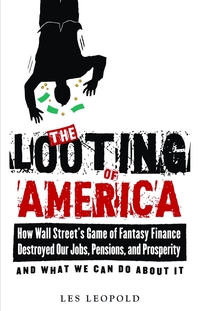The following is an excerpt from The Looting of America: How Wall Street's Game of Fantasy Finance Destroyed Our Jobs, Pensions, and Prosperity–and What We Can Do About It, by Les Leopold, now available from Chelsea Green.
There's an unexpected link between the richest residents of Whitefish Bay and the financial toxic waste that came back to haunt them. That story starts in the early 1970s, when something strange happened to our economy: An iron law of economics melted down.
At that time, I was trudging through graduate school, where I learned that workers' wages (that is, "real" wages, after accounting for inflation) are tied to labor's productivity –output per hour worked. Our professors all but rapped our knuckles as they drilled it in: Productivity and real wages are two sides of a coin, forever joined. As workers produce more goods and services per hour (that is, increase their productivity), their wages must rise. Why? Because as productivity rises, firms will increase profits by seeking more workers, which in turn bids up the price of labor. My microeconomics teachers even argued that other forces, like collective bargaining, really can't change this relationship. For instance, if unions push wages up faster than productivity, either inflation will kick in, bringing real wages back down, or employers will start laying people off, increasing the supply of labor and reducing its price.
So went the theory, and the proof was right before our eyes in the post-World War II productivity-and-wage data. As output per worker-hour went up, average workers' real wages rose in tandem. They tracked nearly perfectly, year after year.
As the United States battled the communists for ideological supremacy, this iron law highlighted the economic might and inherent justice of American capitalism. Output per worker just kept rising, and the economy just kept growing, as measured by gross domestic product (GDP)-the value of all our goods and services. And as workers' real wages rose, the average working family could buy more of the goods and services they produced. Our standard of living grew more steadily and faster than anywhere else on earth. In short, the iron law of economics I learned in grad school was the foundation of the American dream. Year after year things would get better for those who worked hard and played by the rules of free enterprise. Each generation would do better than the previous one.
And then, suddenly, everything changed. Productivity and wages, American workers discovered, weren't inextricably linked after all. Starting in the mid 1970s, productivity was still rising- sometimes slowly, sometimes quickly, for a total increase of 94 percent in the past three decades. But wages went flat beginning in 1973, and they are still flat or declining today.
The average nonsupervisory worker actually earned more in 1973 than today, in real (inflation-adjusted) dollars. Consider chart 2, which shows what real weekly wages would have been had they continued to rise in lockstep with productivity. (The top line is the productivity index converted into wages and so is called productivity-enhanced wages.) The two lines are snugly aligned from 1947 to about 1973. Then they diverge as average real wages stall and then decline.
Chart 2. Actual Wages vs. Productivity-Enhanced Wages in the United States. Author's calculations using Bureau of Labor Statistics data
By 2007, real wages (in today's dollars) had slid from their peak of $746 per week in 1973 to $612 per week — an 18 percent drop. Had wages increased along with productivity, the current average real wage for nonsupervisory workers would be $1,171 per week-$60,892 per year instead of today's average of $31,824.
Consider the implications. Although their wages stopped rising, workers were getting more and more productive with each hour they worked. As a result, the economy was growing, with ever more goods and services produced per worker-hour. The money value of those goods and services had to go somewhere. Clearly workers didn't take that money home. So who did?
Maybe that mysteriously disappearing productivity bonus went to pay for our benefits-like health care. We know health care costs have shot up. Is that where our lost wage increases went?
No, not according to the numbers. Chart 3 tracks real hourly total compensation for all workers (except farmers) — which includes every employee cost borne by the employer –wages, pensions, health care, vacations, paid leave, unemployment insurance, disability, and Social Security. As is clear, that telltale post-1973 gap between wages and productivity is still there. Our average real hourly compensation is now about $25 per hour including all benefits, representing a small increase from the early 1970s. If it had risen along with productivity, it would be more like $41 an hour. The productivity bonus-about $16 per hour-is still AWOL.
I'm sure you've guessed where it went: Nearly all of it was snatched by the owners of capital-the wealthiest of the "investment class." In 1973 the top 1 percent of earners took in 8 percent of the nation's total income. By 2006, the top 1 percent got nearly 23 percent of the pie, the highest proportion since 1929.
Chart 3. Real Hourly Total Compensation vs. Productivity, U.S. Non-farm Business Sector 1947-2008 (3rd Q). Author's calculations using Bureau of Labor Statistics data
As real wages stalled, more and more families relied on two wage earners to make ends meet. Between the addition of a second wage earner, the addition of second jobs for individual wage earners, and working longer hours, the average married couple increased their total number of hours worked per year by 25 percent from 1950 to 2005.2 Nevertheless, as chart 4 shows, even with that increase in work time, household income for working people rose modestly over the past twenty-five years, or not at all. Clearly our productivity gains have found their way into the pockets of the wealthy, like those who live in Whitefish Bay's shoreline mansions.
There are 94 million nonsupervisory workers out there who are not getting their fair share of the spoils of their increased productivity. An estimate for just the most current year-one year-of the gap between what workers should have gotten and what they actually received (in wages and benefits) is a staggering $3 trillion — equivalent to about $32,000 per worker in the United States. Most of that money went instead to the investor class all over the world.
Chart 4. Change in Real Family Income by Quintile and Top Five Percent, 1979-2006. U.S. Census Bureau, Historical Income Tables, F1, F3
And what exactly did those rich investors do with our money? They spent some of it on themselves, to be sure. But even they can only buy so many houses, cars, and jets. In fact, the rich invested most of this unearned bonus. (It always feels better to have your money make money-and then spend it.)
Some of the money was invested in old-fashioned places like factories, or even in newfangled start-ups. But there was so much money roaming the globe that it ran out of "real" economy investments. Instead, much of this massive surplus found its way into high finance. Investors here and around the globe stocked up on some very fancy financial instruments that had only a tenuous relationship with the brick-and-mortar economy.
Imagine that "real" economic production of tangible goods and services takes place on the surface of the earth. And imagine that finance is the atmosphere-the clouds and the air that allow our real earthly economic entities to breathe and grow through loans and other access to capital. This financial atmosphere is directly connected to real production, because all loans are claims on the real assets of the global economy. The financial "air" is made of financial markets (often called capital markets) and financial instruments (stocks, bonds, etc.) that move capital from those who have it to those who need it-at least in theory. The financial air brings cash to enterprises that require it. New companies get the start-up money they need; businesses and consumers get credit to buy goods and services that they couldn't afford otherwise.
To run properly, our economy needs just the right amount of financial air. If there's not enough, banks choke up. And when banks stop lending, you get a financial crisis — like now. But you also can get too much financial air-more than the real economy back on earth can handle. And when the conditions are right, that excess of financial air can blow into a perfect economic storm.
If we sum up all the productivity bonuses workers haven't gotten since 1973, it's easy to see how the financial skies would be filling with clouds of capital looking for a home. While some of that money was productively invested in the real global economy, trillions of dollars of surplus capital found its way into the fantasy-finance casino. Here's how Wall Street Journal reporters Greg Ip and Mark Whitehouse put it in 2005:
There's an unprecedented wave of capital flowing around the world, with all of its owners anxiously searching for a better return. World pension, insurance and mutual funds have $46 trillion at their disposal, up almost a third from 2000. . . .
The result is that global investors are diving into a wide range of riskier assets: emerging countries' stocks and bonds; real estate and real-estate-backed debt; commodity funds; fine art; private-equity funds, which buy stakes in nonpublic companies; and the investment contracts called derivatives, including a kind structured to permit the sophisticated to take huge bond risks.
To suck up this surplus capital, the financial sector invented scores of spanking new financial instruments for the wealthy to buy. Just a few years later, those deliciously high-yielding investments turned into financial toxic waste, plunging our economy into a deep and dangerous recession.
The story gets stranger still. As Wall Street soared on the wings of its great new financial instruments, more money became available for loans . . . to working people. And workers, whose wages had dragged for decades because they didn't get their productivity bonuses, really racked up the debt-in the form of mortgages, credit card debt, auto and student loans. We were borrowing back our own money!
Chart 5 shows the rise of our indebtedness. From about 1960 to 1985, at any one moment in time, we owed about $0.60 for every dollar we earned in a year (after taxes). But as the productivity wage gap widened, we started to borrow more and more. As of 2006, we owed $1.27 for every dollar we earned.
To jump ahead in our story a bit, this ever-rising level of household debt was unsustainable. There's a finite limit to how much debt working people could take on to buy more and more goods and services. When they hit the wall, consumer demand crashed
and the economy suffered.
Chart 5. Household Debt-to-Income Radio in the United States. Federal Reserve Board and Bureau of Economic Analysis data from www.demographia.com/#econ
But that's not the main reason our economy took a nose dive. Far from it. In fact, a good deal of the surplus capital the wealthy skimmed from us did not get recycled back to us as debt. No, much of it went into the fantasy finance casino and turned into bets, just like the ones that were pawned off on the Wisconsin school districts. Our story is about how those new financial investments were created and how they turned toxic, crashing the financial sector and then the rest of the economy.
In honor of Whitefish Bay, I propose a new iron law of economics very different from the one I learned in graduate school. It goes something like this: When we allow surplus capital to pile up in the hands of the few, the money will be pumped into a fantasy-finance casino that will ultimately crash the economy. And here's the unfortunate corollary: When that casino goes bust, we pay yet again — in lost jobs and pensions-and in tax dollars to bail out the biggest financial institutions that crashed the system in the first place.













